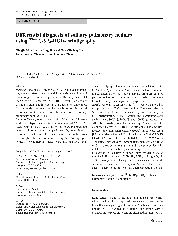摘要
Purpose Targeting of integrin alpha(nu)beta(3) with molecular imaging agents offers great potential in early detection and monitoring of tumour angiogenesis. Recently, an RGD (Arg-Gly-Asp) tracer, Tc-99m-3P(4)-RGD(2), with high affinity to integrin alpha(nu)beta(3) and in vivo tumour uptake was developed. In this study, we evaluate the feasibility of this novel radiotracer in the noninvasive differentiation of solitary pulmonary nodules (SPNs).
Methods Twenty-one patients with SPNs on CT were studied scintigraphically after administration of Tc-99m-3P(4)-RGD(2) with a dose of 939 +/- 118 MBq. Image interpretation using a 5-point scale was performed by one thoracic radiologist for CT and three nuclear medicine radiologists for single photon emission computed tomography (SPECT). Scintigraphic images were also analysed semi-quantitatively by calculating tumour to normal tissue ratio (T/N). The "gold standard" was based on the histopathological diagnosis of the surgical samples from all recruited patients. A fraction of the samples were analysed immunohistochemically for integrin alpha(nu)beta(3) expression.
Results Among the 21 SPNs, 15 (71%) were diagnosed as malignant and 6 (29%) were benign. The mean size for SPNs was 2.2 +/- 0.6 cm. The sensitivity and specificity for CT interpretation, SPECT visual and semiquantitative analysis were 80/67%, 100/67% and 100/67%, respectively. All SPNs classified as indeterminate by CT were correctly diagnosed by Tc-99m-3P(4)-RGD(2) scintigraphy. The empirical receiver-operating characteristic (ROC) areas were 0.811 [95% confidence interval (CI) 58-95%] for CT, 0.833 (95% CI 61-96%) for SPECT and 0.844 (95% CI 62-96%) for T/N ratios, respectively. Immunohistochemistry confirmed alpha(nu)beta(3) expression in malignant and benign nodules with uptake in Tc-99m-3P(4)-RGD(2) scintigraphy.
Conclusion In this first-in-human study, we demonstrated the feasibility of using Tc-99m-3P(4)-RGD(2) scintigraphy in differentiating SPNs. This procedure appears to be highly sensitive in detection of malignant SPNs. SPECT visual analysis seems to be sufficient for characterization of SPNs.
